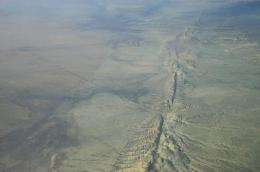This is the San Andreas Fault. Credit: Wikipedia
Geoscientists at the University of Liverpool have used friction experiments to investigate the processes of fault slip.
Fault slip occurs in many natural environments - including during earthquakes - when large stress build-ups are rapidly released as two sliding tectonic plates grinds together. In this process a large amount of the energy released can be converted to heat, that leads to frictional melting.
Frictional melts, when cooled, preserve in the rock-record as pseudotachylytes; but their influence is much greater than just this. As Professor Lavallée and co-workers have demonstrated, the flow properties of the frictional melt helps control fault slip.
The researchers, from the University's School of Environmental Sciences, warn of the inadequacy of simple Newtonian viscous analyses to describe molten rock along faults, and instead call for the more realistic application of viscoelastic theory.
Melt may be considered a liquid, which is able to undergo a glass transition, as a result of changing temperature and/ or strain-rate. This catastrophic transition allows the melt to either flow or fracture, according to the fault slip conditions.
Professor Lavallée said: "Even once frictional melt forms, slip can continue as if there was no melt; if the slip rate is fast enough the melt behaves as a solid."
Using slip analysis models, the researchers describe the conditions that result in either viscous remobilisation or fracture of the melt, a description which will be of great use in the understanding of fault slip in melt-bearing slip zones.
Professor Lavallée added: "This new description of fault slip is not just important for our understanding of earthquake fault rheology, it has far reaching implications for magma transport in volcanic eruptions, for landslide and sector collapse instabilities, and within material sciences; namely for the glass and ceramic industries."
More information: Fault rheology beyond frictional melting, Yan Lavallée, PNAS, DOI: 10.1073/pnas.1413608112
Abstract
During earthquakes, comminution and frictional heating both contribute to the dissipation of stored energy. With sufficient dissipative heating, melting processes can ensue, yielding the production of frictional melts or "pseudotachylytes." It is commonly assumed that the Newtonian viscosities of such melts control subsequent fault slip resistance. Rock melts, however, are viscoelastic bodies, and, at high strain rates, they exhibit evidence of a glass transition. Here, we present the results of high-velocity friction experiments on a well-characterized melt that demonstrate how slip in melt-bearing faults can be governed by brittle fragmentation phenomena encountered at the glass transition. Slip analysis using models that incorporate viscoelastic responses indicates that even in the presence of melt, slip persists in the solid state until sufficient heat is generated to reduce the viscosity and allow remobilization in the liquid state. Where a rock is present next to the melt, we note that wear of the crystalline wall rock by liquid fragmentation and agglutination also contributes to the brittle component of these experimentally generated pseudotachylytes. We conclude that in the case of pseudotachylyte generation during an earthquake, slip even beyond the onset of frictional melting is not controlled merely by viscosity but rather by an interplay of viscoelastic forces around the glass transition, which involves a response in the brittle/solid regime of these rock melts. We warn of the inadequacy of simple Newtonian viscous analyses and call for the application of more realistic rheological interpretation of pseudotachylyte-bearing fault systems in the evaluation and prediction of their slip dynamics.
Journal information: Proceedings of the National Academy of Sciences
Provided by University of Liverpool























